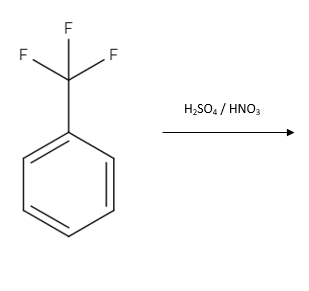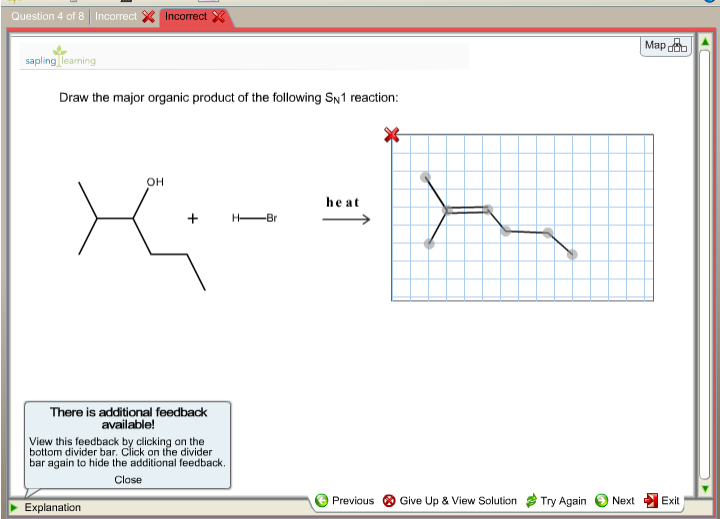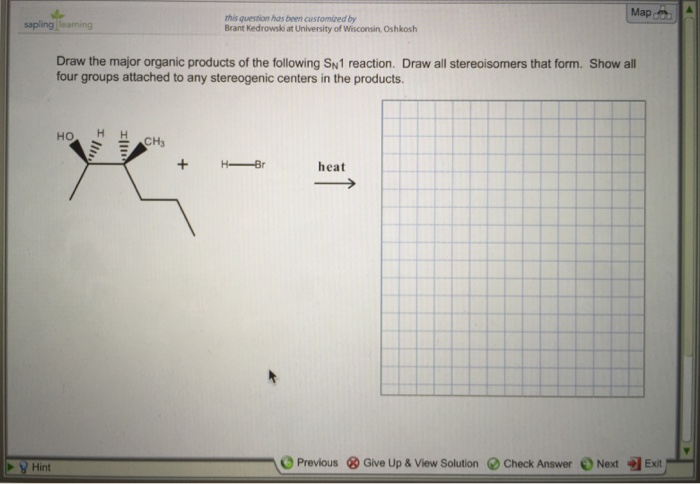56++ Draw The Major Organic Product Of The Following Sn1 Reaction Ideas in 2022
Draw the major organic product of the following sn1 reaction Select the correct IUPAC name for the following organic substrate including the R or S designation where appropriate and draw the major organic products for the SN1 reaction.
Draw the major organic product of the following sn1 reaction. For the following SN1 reaction draw the major organic product identify the nucleophile substrate and leaving group and determine the rate limiting step. V 2 O 5 Ca VCaO aBalanced the reaction equation. 21 Full PDFs Sep 09 2008 Reactions. Add additional sketchers using the drop-down menu in the bottom right corner. Draw the major organic product of the following SN1 reaction Show transcribed image text Draw the major organic product of the following SN1 reaction. Answer to Draw the major organic product of the following SN1 reaction. Draw the major organic products of the following reaction. Draw one structure per sketcher. When SN1 El pathways compete show both the substitution and the elimination products. You do not have to consider stereochemistry. Separate multiple products using the sign from the dropdown menu. H_3C---Br NaOH rightarrow You do not have to consider stereochemistry.
I Know That It Is Not Where The. This is hydride shift which allows to switch the hydrogen from the tertiary carbon with the carbocation in secondary carbon. Homework answers question archive For the following SN1 reaction draw the major organic product identify the nucleophile substrate and leaving group and determine the rate limiting step. 5draw the major organic product of the following reaction. Draw the major organic product of the following sn1 reaction Jul 22 2018 Draw the major product for the following reaction showing the stereochemistry by using wedge bonds. B- Calculate the moles of given reactants. Learn this topic by watching SN1 Reaction Concept Videos. Br NaOH You do not have to consider stereochemistry. Draw the major organic products of the following reaction. Draw the major organic products of the following reaction. In a reaction 077 kg of V 2 O 5 are reacted with 088 kg of Ca as the following chemical. And Br is the leaving group. If no reaction occurs draw the organic starting material.
 Draw The Major Organic Product S For The Following Reaction Multiple Products May Be Drawn In One Box In Any Order Include Charges As Needed Study Com
Draw The Major Organic Product S For The Following Reaction Multiple Products May Be Drawn In One Box In Any Order Include Charges As Needed Study Com
Draw the major organic product of the following sn1 reaction Learn this topic by watching SN1 SN2 E1 E2 Chart Big Daddy Flowchart Concept Videos All Organic Chemistry Practice Problems SN1 SN2 E1 E2 Chart Big Daddy Flowchart Practice Problems.

Draw the major organic product of the following sn1 reaction. Expert Answer 97 33 ratings. Show transcribed image text. For the following SN1 reaction draw the major organic product identify the nucleophile substrate and leaving group and determine the rate limiting step.
From the hint given I suspect this chloro compound is what the instructor wants although it is unlikely to be the major product. Separate multiple products using the sign from the drop-down menu. Draw the major organic products of the following reaction.
You do not have to consider stereochemistry. If no reaction occurs draw the organic starting material. Try to correlate the structure of the alkyl bromide with the type of carbocation that will be formed.
If no reaction occurs draw the organic starting material When SN1 E1 pathways compete show both the substitution and the elimination products. C- Calculate the moles of product V. Draw the major organic products of the following reaction.
For the following SN1 reaction draw the major organic product identify the nucleophile substrate and leaving group and determine the rate limiting step. For the following SN2 reaction draw the major organic product and select the correct R or S designation around the stereocenter carbon in the organic substrate and organic product. Draw The Major Organic Product Of The Following SN1 Reaction.
Draw the major organic product of the following SN1 reaction. That will form an intermediate product secondary carbocation. H3C H2O solvent Select the statement that properly identifies the nucleophile substrate and leaving group.
The alcohol is more likely at lower temperatures it is also a product of SN1 and the alkenes are more likely at higher temperatures. 2-CHLORO 3-DIMETHYL PENTANE CH3CH2OH -----isopropyl alcohol By signing up. Draw the major organic product for the following reaction.
C7HsBr is the substrate H2O is the nucleophile. The following JSMOL images show a series of alkyl bromides and their relative rates of reaction in an S N 1 hydrolysis. I Know That It Is Not Where The Br Replaces The OH.
Draw the major organic product of the following S N 1 reaction. Now you should be careful about rearrangement. Draw The Major Organic Product Of The Following SN1 Reaction.
The gas constant R 8. You will get tertiary carbocation. I will leave to you the final part when the bromine -1 attacks the.
Draw the two major organic products of the following reaction. Rank the SN1 reaction rates for the following compoundsA chloromethane B 3-chloro-3-methylpentane C 1-chloro-3-methylpentane D. Draw the major organic product of the following SN1 reaction Show transcribed image text Draw the major organic product of the following SN1 reaction.
This problem has been solved.
Draw the major organic product of the following sn1 reaction This problem has been solved.
Draw the major organic product of the following sn1 reaction. Draw the major organic product of the following SN1 reaction Show transcribed image text Draw the major organic product of the following SN1 reaction. Rank the SN1 reaction rates for the following compoundsA chloromethane B 3-chloro-3-methylpentane C 1-chloro-3-methylpentane D. Draw the two major organic products of the following reaction. I will leave to you the final part when the bromine -1 attacks the. You will get tertiary carbocation. The gas constant R 8. Draw The Major Organic Product Of The Following SN1 Reaction. Now you should be careful about rearrangement. Draw the major organic product of the following S N 1 reaction. I Know That It Is Not Where The Br Replaces The OH. The following JSMOL images show a series of alkyl bromides and their relative rates of reaction in an S N 1 hydrolysis.
C7HsBr is the substrate H2O is the nucleophile. Draw the major organic product for the following reaction. Draw the major organic product of the following sn1 reaction 2-CHLORO 3-DIMETHYL PENTANE CH3CH2OH -----isopropyl alcohol By signing up. The alcohol is more likely at lower temperatures it is also a product of SN1 and the alkenes are more likely at higher temperatures. H3C H2O solvent Select the statement that properly identifies the nucleophile substrate and leaving group. That will form an intermediate product secondary carbocation. Draw the major organic product of the following SN1 reaction. Draw The Major Organic Product Of The Following SN1 Reaction. For the following SN2 reaction draw the major organic product and select the correct R or S designation around the stereocenter carbon in the organic substrate and organic product. For the following SN1 reaction draw the major organic product identify the nucleophile substrate and leaving group and determine the rate limiting step. Draw the major organic products of the following reaction.
C- Calculate the moles of product V. If no reaction occurs draw the organic starting material When SN1 E1 pathways compete show both the substitution and the elimination products. Try to correlate the structure of the alkyl bromide with the type of carbocation that will be formed. If no reaction occurs draw the organic starting material. You do not have to consider stereochemistry. Draw the major organic products of the following reaction. Separate multiple products using the sign from the drop-down menu. From the hint given I suspect this chloro compound is what the instructor wants although it is unlikely to be the major product. For the following SN1 reaction draw the major organic product identify the nucleophile substrate and leaving group and determine the rate limiting step. Show transcribed image text. Expert Answer 97 33 ratings. Draw the major organic product of the following sn1 reaction.
Draw the major organic product of the following sn1 reaction

 Organic Chemistry 331 Sapling Learning Ch 9 Flashcards Quizlet
Organic Chemistry 331 Sapling Learning Ch 9 Flashcards Quizlet